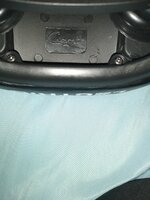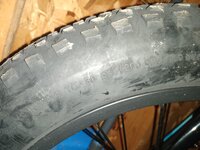RickyBikes
Member
- Region
- USA
The Lectric XP 2.0 is an affordable entry-level folding eBike from one of the fastest growing eBike brands in North America since their inception in 2019. This is the second generation of the enormously popular XP. Like the original XP, the 2.0 is available in black or white and as either a mid-step or step-through model. The low stand-over height on either model makes it an approachable eBike. Although it looks nearly identical to the original XP, the 2.0 has a few upgraded features and still maintains an affordable price at $999.00.
Highlights of this model include the variable front oil suspension, a slightly smaller tire, wider handlebars, IP-65 water and dust resistant electrical components, and additional mounting points for baskets, mirrors, locks, or other accessories. Here's their official website www.lectricebikes.com and I'd love to hear your thoughts below, especially if you own the Lectric XP 2.0 or plan to buy it!
While I haven't reviewed this electric bike myself, I have covered similar eBikes (you can also find Court’s review of the original Lectric XP here) and I wanted to provide some insights and open things up for your feedback. I hope providing several sources, with varying perspectives, allows everyone to come to their own conclusions. Sometimes short reviews and those created by shops only cover the good aspects and can come off like a commercial, so I've tried to be neutral and objective with these insights:
Pros – things that stand out as good:
Cons – things that seem like trade-offs or negatives:
As always, I welcome feedback and additions to these pros and cons, especially from people who have tried or own the bike. If you see other great video reviews for the Lectric XP 2.0, please share them and I may update this post ongoing so we can get the best perspectives and insights.
Highlights of this model include the variable front oil suspension, a slightly smaller tire, wider handlebars, IP-65 water and dust resistant electrical components, and additional mounting points for baskets, mirrors, locks, or other accessories. Here's their official website www.lectricebikes.com and I'd love to hear your thoughts below, especially if you own the Lectric XP 2.0 or plan to buy it!
While I haven't reviewed this electric bike myself, I have covered similar eBikes (you can also find Court’s review of the original Lectric XP here) and I wanted to provide some insights and open things up for your feedback. I hope providing several sources, with varying perspectives, allows everyone to come to their own conclusions. Sometimes short reviews and those created by shops only cover the good aspects and can come off like a commercial, so I've tried to be neutral and objective with these insights:
Pros – things that stand out as good:
- I’ve got to hand it to the Lectric team, the biggest trade-off on the original XP was the lack of front suspension forks. They listened to their customers and outfitted the XP 2.0 with variable front oil suspension. The original XP had 4” fat-tires, which can offset some of the need for front and rear suspension and still provide a comfortable ride, but with this model they’ve accounted for the weight of the added suspension forks by providing slightly smaller 3” plus-sized tires. Those smaller tires can provide a little more agility, faster acceleration, and slightly better hill climbing capabilities than fat-tires.
- Like its predecessor, the 2.0 comes fully assembled with free shipping and ready to ride which for new riders is an invaluable luxury. It also offers the same generous 330lb max payload capacity. I like that the rear load capacity has also increased to a 75lb max load from 55lbs.
- The 2.0 sports larger handlebars than the previous generation while maintaining that nice ergonomic grip to add comfort to the ride. Pair this with the adjustable stem, seat post, and suspension forks, and it allows for a greater variety of riders despite the bike coming in only one frame size. As someone 6’3 with a 6’5 wingspan, this a great added feature.
- For such an inexpensive bike, Lectric provides a tested, warranty supported motor and takes care of their customers. Providing a 1-year comprehensive warranty and great customer support is rare for bikes on this cheaper end of the spectrum. I particularly like the display – it’s nice and visible even in daylight, and the energy bar has ten ticks, so it's going to be a more precise gauge
- Battery is high quality cells (LG), fully inside the frame which protects it, yet also removable when the frame is folded. Really great feature and a lot of folding bikes in this price range have either non-removable batteries, or batteries awkwardly mounted somewhere outside on the frame. Many cheaper bikes sacrifice battery capacity and quality, which makes them attractive for first purchase but then you have to spend hundreds of $ later down the road to replace a battery that probably requires a special expert to service.
Cons – things that seem like trade-offs or negatives:
- This bike is steel, which means it’s sturdy and quiet, but the tradeoff is that 1) it’s a heavier folding bike (63lbs) and 2) if it gets scratched or dinged then it might require a glossy paint touch-up to prevent rusting.
- The 2.0 still uses some lower-end components. For example, it has the entry-level Shimano Tourney derailleur, a 7-gear freewheel rather than a more durable free hub and cassette, 160mm Tektro mechanical brakes (mechanical disc brakes require more maintenance and grip strength compared to hydraulic brakes). The tradeoff comes down to the price point. Considering this is such an affordable bike, some of the compromise is found in those components. It still produces 60Nm of torque and both brake levers have motor inhibitors. All things considered, the nice display, battery, integrated lights, motor inhibitors, and cadence sensor are all areas where you shouldn’t want to compromise, and Lectric did a nice job of finding a balance between utility and value.
- This is a bit of a trade-off, but at the bottom of the downtube one must insert a key at the bottom of the battery and turn it to arm the bike and ride it. It’s in a slightly awkward position if you’re an older, taller, or less mobile rider. The key will dangle under you as you ride, so if you had a keychain or other keys attached, it’s possible they could interfere with your feet or hit the pedals as you ride. It is a nice security feature, however, considering the bike won’t be tampered with without the key.
- It would be nice if this bike had USB ports for charging a phone, a small stereo or additional lights. When you receive your bike, it is automatically set to a Class 2 setting (capping out at 20mph). You can manually program the bike to run as a Class 3 (capping out at 28mph) but you must do so through the display. This requires holding down both the up and down arrows for several seconds, and then combing through twenty different menus to do so. It’s a little convoluted process, but considering that you can switch between a Class 2 and a Class 3, it’s just a tradeoff.
- Still no sidewall striping on the tires or reflectors on the spokes. On the black model this means very low side visibility. The white one is better for folks riding at night or with lots of traffic.
- This is an online only bike, meaning 1) no way to test ride before buying, and 2) no dealer support for maintenance or warranty repairs. Yes, Lectric does have a great reputation for support, but the process is still much more hassle than being able to just take the bike into your local Trek or Giant dealer.
As always, I welcome feedback and additions to these pros and cons, especially from people who have tried or own the bike. If you see other great video reviews for the Lectric XP 2.0, please share them and I may update this post ongoing so we can get the best perspectives and insights.
Last edited:


